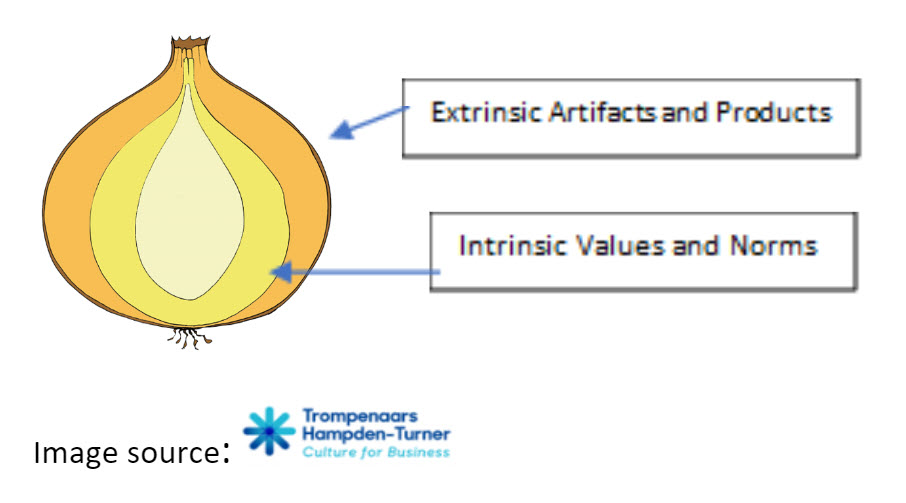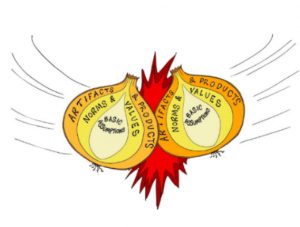Edgar Schein (1928 – 2023), the founder of the discipline of organizational behavior, was a prominent contributor to the fields of organizational development and organizational culture. Schein’s work helps us recognize the hidden sources of cultural differences and unconscious biases in an organization, which helps leadership manage cultural dynamics and align people and departments with shared organizational values.
Where does organizational culture come from?
Schein differentiated between extrinsic and intrinsic elements of culture. Extrinsic culture refers to the products and artifacts of a culture, while intrinsic culture refers to the implicit meaning and shared understanding of those extrinsic products and artifacts by members of the same group. Organizational culture exists analogically in statements such as “This is the way we do things around here” or “We only behave that way when the boss is around.” The statements hold little meaning to the outsider of a group but are implicitly understood by members of the group. Hidden elements of organizational culture are at play when you begin a new job, for example. When you start in a new position, you may be at a loss as to how workplace rituals are observed, and expectations met.
Schein noted that culture is multilayered. Trompenaars Hampden-Turner’s image of an onion can be used as a model of culture.
A Model of Culture

At the outermost layer of an onion are visible artifacts, products and expressions at work that we can see and hear, such as the way people dress, standards for meetings, the pace of work, and so on. Extrinsic elements of a culture are recognized as different or unique by people from outside that culture, and what informs the extrinsic layer is hidden by the second layer.
 Beneath the extrinsic layer are values and norms. Values are things we like to do and have specific meaning; they help us solve problems and are sometimes not easily explained because group members implicitly understand them. When values are shared, they become norms. As norms become deeply held beliefs, they evolve into basic assumptions, the third and innermost layer of culture. Assumptions exist as unconscious beliefs and behaviors. Like a fish that only becomes aware of the water in which it lives when removed from it, we become aware of basic assumptions when our deeply held expectations or values are not respected.
Beneath the extrinsic layer are values and norms. Values are things we like to do and have specific meaning; they help us solve problems and are sometimes not easily explained because group members implicitly understand them. When values are shared, they become norms. As norms become deeply held beliefs, they evolve into basic assumptions, the third and innermost layer of culture. Assumptions exist as unconscious beliefs and behaviors. Like a fish that only becomes aware of the water in which it lives when removed from it, we become aware of basic assumptions when our deeply held expectations or values are not respected.
When cultures clash, they do so at the explicit layer. A culture clash can create shock, frustration, confusion, or feelings of helplessness. We cannot see a value, but we know when a value is different from our own or when our values are not respected. The result can be a culture clash.
Hidden values and meanings at work can emerge as differences that are not understood or respected. Schein’s model shows that where deeply implicit biases exist, they can be both unconscious and hidden.
Organizations with ambitious programs to change implicit behaviors or create new values must proceed with change management techniques and learning that allow people to recognize their own culture and then appreciate or respect differences. Recognition and respect are two intercultural competencies involved in human relations. Schein’s model helps explain the sources of cultural value differences and basic assumptions and how appreciation of differences can emerge.
The hidden forces of culture are never fully clear. Still, by developing our cultural skills and competencies to recognize and respect differences, we can better appreciate and mutually enjoy the array of diversity that exists at work.
Tips for Understanding Cultural Dynamics
- Seek first to recognize your own culture. This recognition involves knowing that the way you do things and your beliefs and assumptions differ from other cultures.
- To recognize a basic assumption, ask yourself what deeply held beliefs you had as a child that you still hold today. Then ask if this belief still holds true, has evolved, or is less true depending on the context.
- Appreciate cultural differences. This appreciation involves seeking to understand how and why things are done differently by other groups. One way to do this is to spend time with people different from you doing something all humans do, such as sharing food or going on a lunch break. Ask questions about how things are normally done on weekends, special occasions, or typical workdays.
- Respecting differences involves moving past “sophisticated stereotypes,” which are highly evolved ideas of what one group is like. Just like no two departments in an organization are exactly alike, no two individuals from the same group are the same. Values change and are different depending on the context and situation.
- As respect for cultural differences deepens, we begin to see where our values may evolve.
Diversity is an MC value that increases with strength the more we understand one another professionally and personally. By using the literal meaning of the Latin root of the word “culture,” to cultivate, we can use some of these suggestions to affect our organizational culture positively.
In memory of Edgar Henry Schein, March 5, 1928 – January 26, 2023
